2011 INFINITI QX56 ignition
[x] Cancel search: ignitionPage 5454 of 5598

WT-4
< PRECAUTION >
PRECAUTIONS
5. When the repair work is completed, re-connect both battery cables. With the brake pedal released, turn
the push-button ignition switch from ACC position to ON position, then to LOCK position. (The steering
wheel will lock when the push-button igniti on switch is turned to LOCK position.)
6. Perform self-diagnosis check of all control units using CONSULT-III.
Service Notice or Precautions for TPMSINFOID:0000000006225485
Low tire pressure warning lamp blinks for 1min, then turns ON when occurring any malfunction except low tire pressure. Erase the self-diagnosis memories for low tire pressure warning control unit, or register the ID
to turn low tire pressure warning lamp OFF. For ID registration, refer to WT-29, "
Work Procedure".
ID registration is required when replacing or rotating wheel s, replacing transmitter or low tire pressure warn-
ing control unit. Refer to WT-29, "
Work Procedure".
Replace grommet seal, valve core and cap of transmitter in TPMS, when replacing each tire by reaching the
wear limit. Refer to WT-66, "
Exploded View".
For tire inflation indicator function, refer to the following.
- When inflating the tires, park the vehicle in the safe area and ensure the safety of the working area.
- Read and understand the tire inflation indicator function prior to use.
- Inflate the tires one at a time.
- If there is no response for approximately 15 seconds or mo re after inflating the tires, cancel the use of the
tire inflation indicator function or move the vehicle approximately 1 m (3.2 ft) backward or forward to try
again. The air filler pressure may be weak or out of service area.
- Despite the high-precision TPMS pressure sensor, an i ndicated value may differ from that of the pressure
gauge.
- Air pressure is measured rather high due to the rise in tire air temperature after driving.
- If TPMS is malfunctioning, the tire inflation indicator is unusable.
Service Notice or Precautions for Road WheelINFOID:0000000006225486
Genuine NISSAN aluminum wheel is designed for each type of vehicle. Use it on the specified vehicle only.
Use Genuine NISSAN parts for the wheel nuts.
Always use them after adjusting the wheel balance. For the balance weights, use Genuine NISSAN alumi-
num wheel weights.
Use caution when handling the aluminum wheels, because they can be easily scratched. When removing
dirt, do not use any abrasives, a wire brush, or other it ems that may scratch the coating. Use a neutral deter-
gent if a detergent is needed.
After driving on roads scattered with anti-ici ng salts, wash off the wheels completely.
When installing road wheels onto the vehicle, always wipe of f any dirt or foreign substances to prevent them
from being trapped between the contact surfaces of wheel.
Never apply oil to nut and bolt threads.
Revision: 2010 May2011 QX56
Page 5458 of 5598
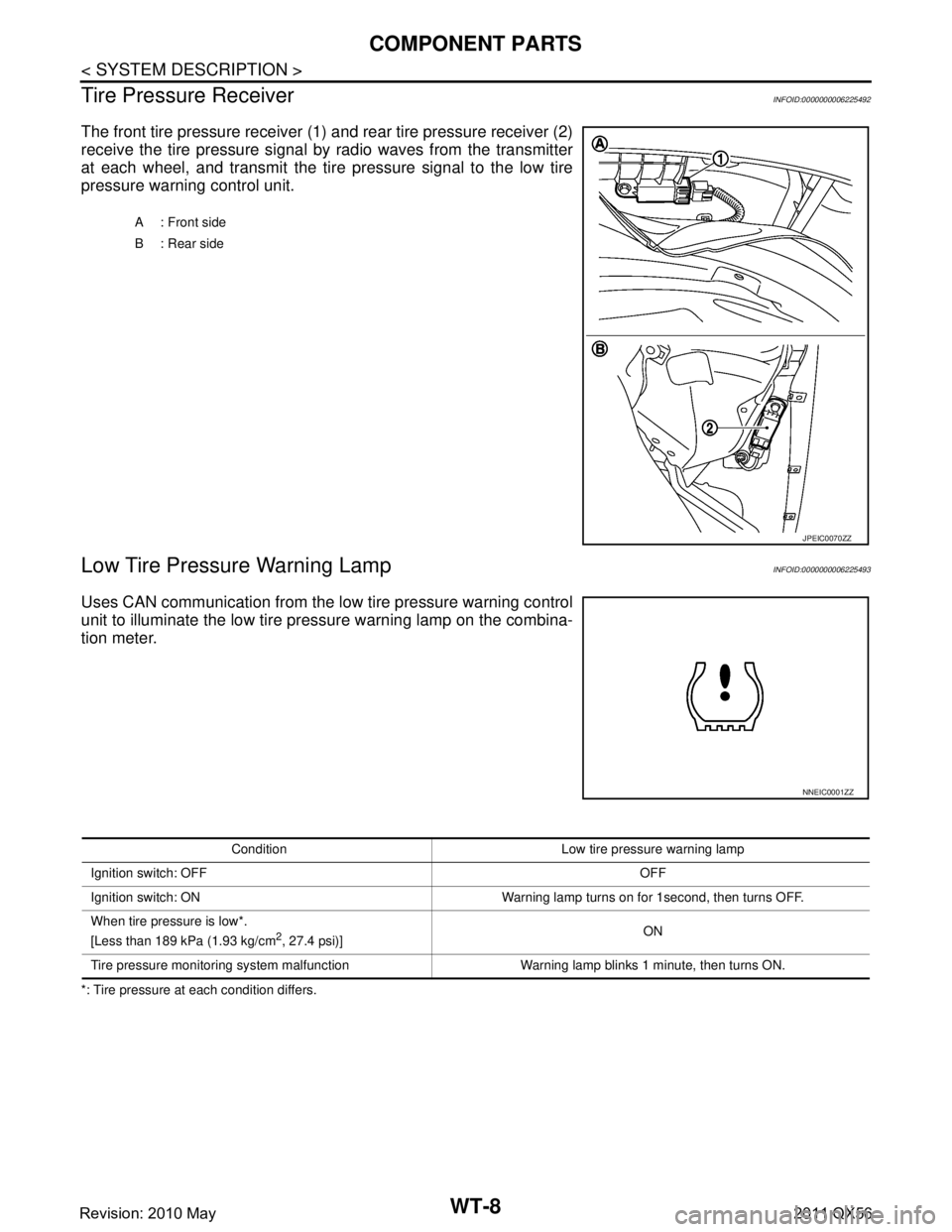
WT-8
< SYSTEM DESCRIPTION >
COMPONENT PARTS
Tire Pressure Receiver
INFOID:0000000006225492
The front tire pressure receiver (1) and rear tire pressure receiver (2)
receive the tire pressure signal by radio waves from the transmitter
at each wheel, and transmit the tire pressure signal to the low tire
pressure warning control unit.
Low Tire Pressure Warning LampINFOID:0000000006225493
Uses CAN communication from the low tire pressure warning control
unit to illuminate the low tire pressure warning lamp on the combina-
tion meter.
*: Tire pressure at each condition differs. A: Front side
B : Rear side
JPEIC0070ZZ
NNEIC0001ZZ
Condition Low tire pr
essure warning lamp
Ignition switch: OFF OFF
Ignition switch: ON Warning lamp turns on for 1second, then turns OFF.
When tire pressure is low*.
[Less than 189 kPa (1.93 kg/cm
2, 27.4 psi)] ON
Tire pressure monitoring system malfunction Warning lamp blinks 1 minute, then turns ON.
Revision: 2010 May2011 QX56
Page 5460 of 5598
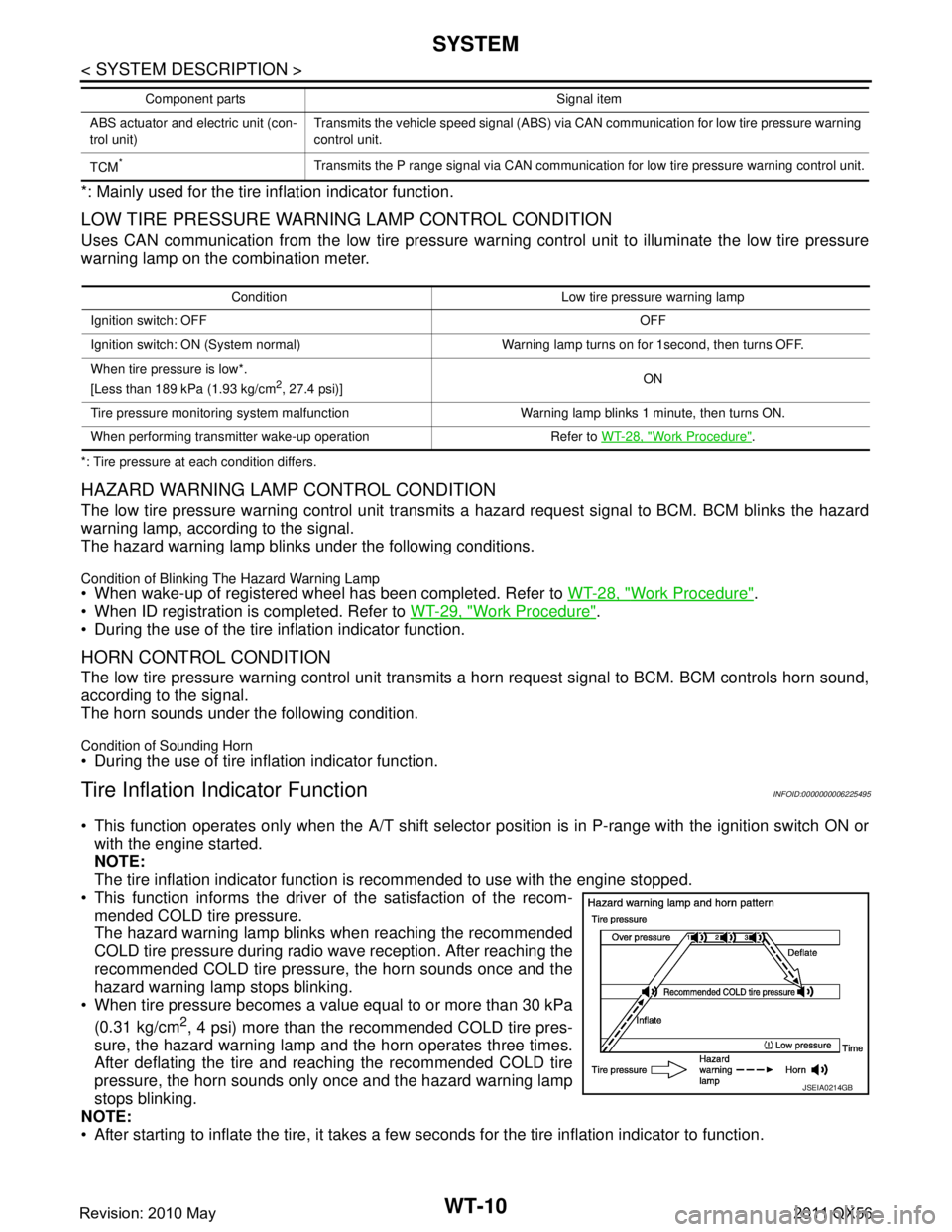
WT-10
< SYSTEM DESCRIPTION >
SYSTEM
*: Mainly used for the tire inflation indicator function.
LOW TIRE PRESSURE WARNING LAMP CONTROL CONDITION
Uses CAN communication from the low tire pressure warning control unit to illuminate the low tire pressure
warning lamp on the combination meter.
*: Tire pressure at each condition differs.
HAZARD WARNING LAMP CONTROL CONDITION
The low tire pressure warning control unit transmits a hazard request signal to BCM. BCM blinks the hazard
warning lamp, according to the signal.
The hazard warning lamp blinks under the following conditions.
Condition of Blinking The Hazard Warning Lamp When wake-up of registered wheel has been completed. Refer to WT-28, "Work Procedure".
When ID registration is completed. Refer to WT-29, "
Work Procedure".
During the use of the tire inflation indicator function.
HORN CONTROL CONDITION
The low tire pressure warning control unit transmits a horn request signal to BCM. BCM controls horn sound,
according to the signal.
The horn sounds under the following condition.
Condition of Sounding Horn During the use of tire inflation indicator function.
Tire Inflation Indicator FunctionINFOID:0000000006225495
This function operates only when the A/T shift selector position is in P-range with the ignition switch ON or
with the engine started.
NOTE:
The tire inflation indicator function is recommended to use with the engine stopped.
This function informs the driver of the satisfaction of the recom- mended COLD tire pressure.
The hazard warning lamp blinks when reaching the recommended
COLD tire pressure during radio wave reception. After reaching the
recommended COLD tire pressure, the horn sounds once and the
hazard warning lamp stops blinking.
When tire pressure becomes a value equal to or more than 30 kPa
(0.31 kg/cm
2, 4 psi) more than the recommended COLD tire pres-
sure, the hazard warning lamp and the horn operates three times.
After deflating the tire and reaching the recommended COLD tire
pressure, the horn sounds only once and the hazard warning lamp
stops blinking.
NOTE:
After starting to inflate the tire, it takes a few seconds for the tire inflation indicator to function.
ABS actuator and electric unit (con-
trol unit) Transmits the vehicle speed signal (ABS) via CAN communication for low tire pressure warning
control unit.
TCM
*Transmits the P range signal via CAN communication for low tire pressure warning control unit.
Component parts Signal item
Condition Low tire pr
essure warning lamp
Ignition switch: OFF OFF
Ignition switch: ON (System normal) Warning lamp turns on for 1second, then turns OFF.
When tire pressure is low*.
[Less than 189 kPa (1.93 kg/cm
2, 27.4 psi)] ON
Tire pressure monitoring system malfunction Warning lamp blinks 1 minute, then turns ON.
When performing transmitter wake-up operation Refer to WT-28, "
Work Procedure".
JSEIA0214GB
Revision: 2010 May2011 QX56
Page 5465 of 5598
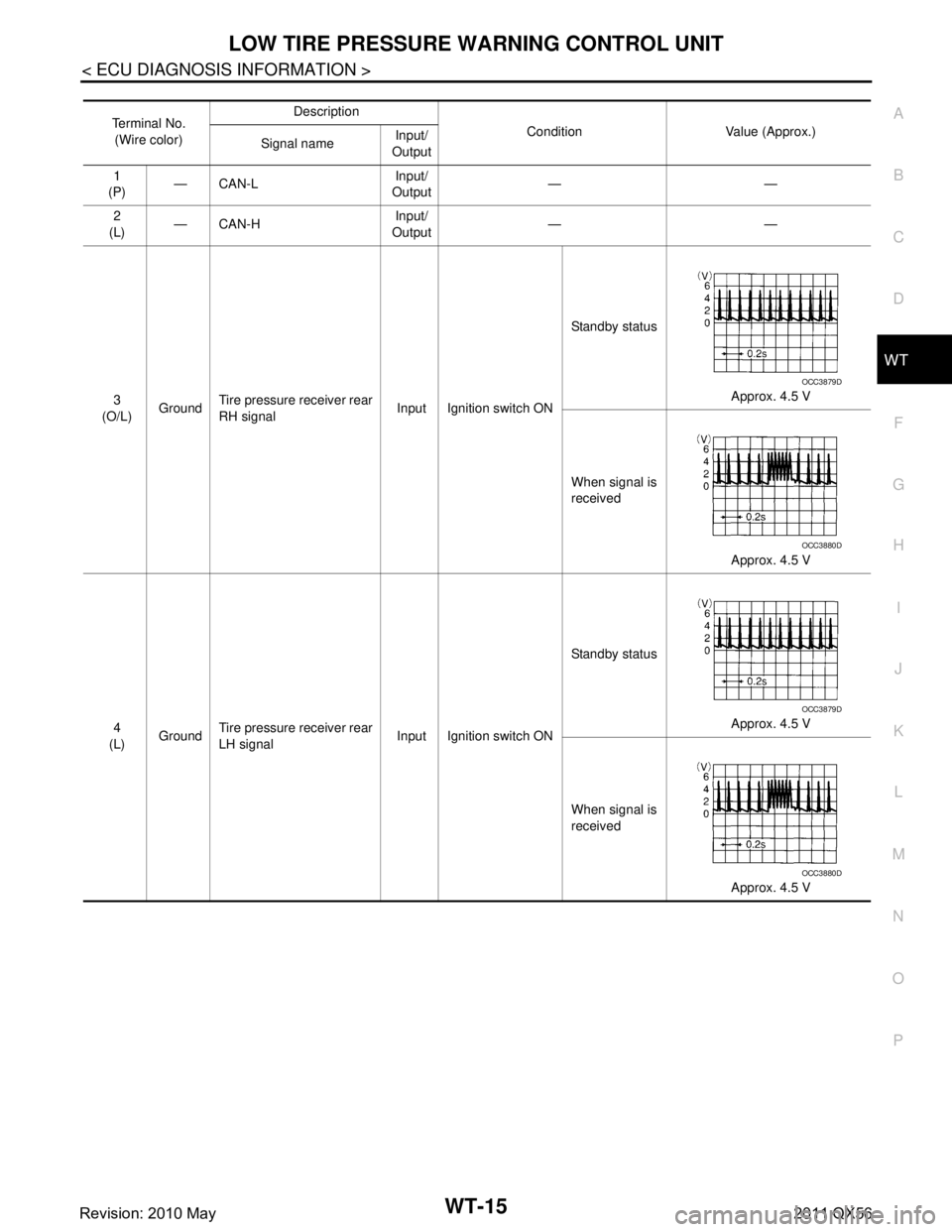
LOW TIRE PRESSURE WARNING CONTROL UNIT
WT-15
< ECU DIAGNOSIS INFORMATION >
C
D F
G H
I
J
K L
M A
B
WT
N
O P
Te r m i n a l N o . (Wire color) Description
Condition Value (Approx.)
Signal name Input/
Output
1
(P) —CAN-L Input/
Output ——
2
(L) —CAN-H Input/
Output ——
3
(O/L) Ground Tire pressure receiver rear
RH signal Input Ignition switch ONStandby status
Approx. 4.5 V
When signal is
received Approx. 4.5 V
4
(L) Ground
Tire pressure receiver rear
LH signal Input Ignition switch ONStandby status
Approx. 4.5 V
When signal is
received Approx. 4.5 V
OCC3879D
OCC3880D
OCC3879D
OCC3880D
Revision: 2010 May2011 QX56
Page 5466 of 5598
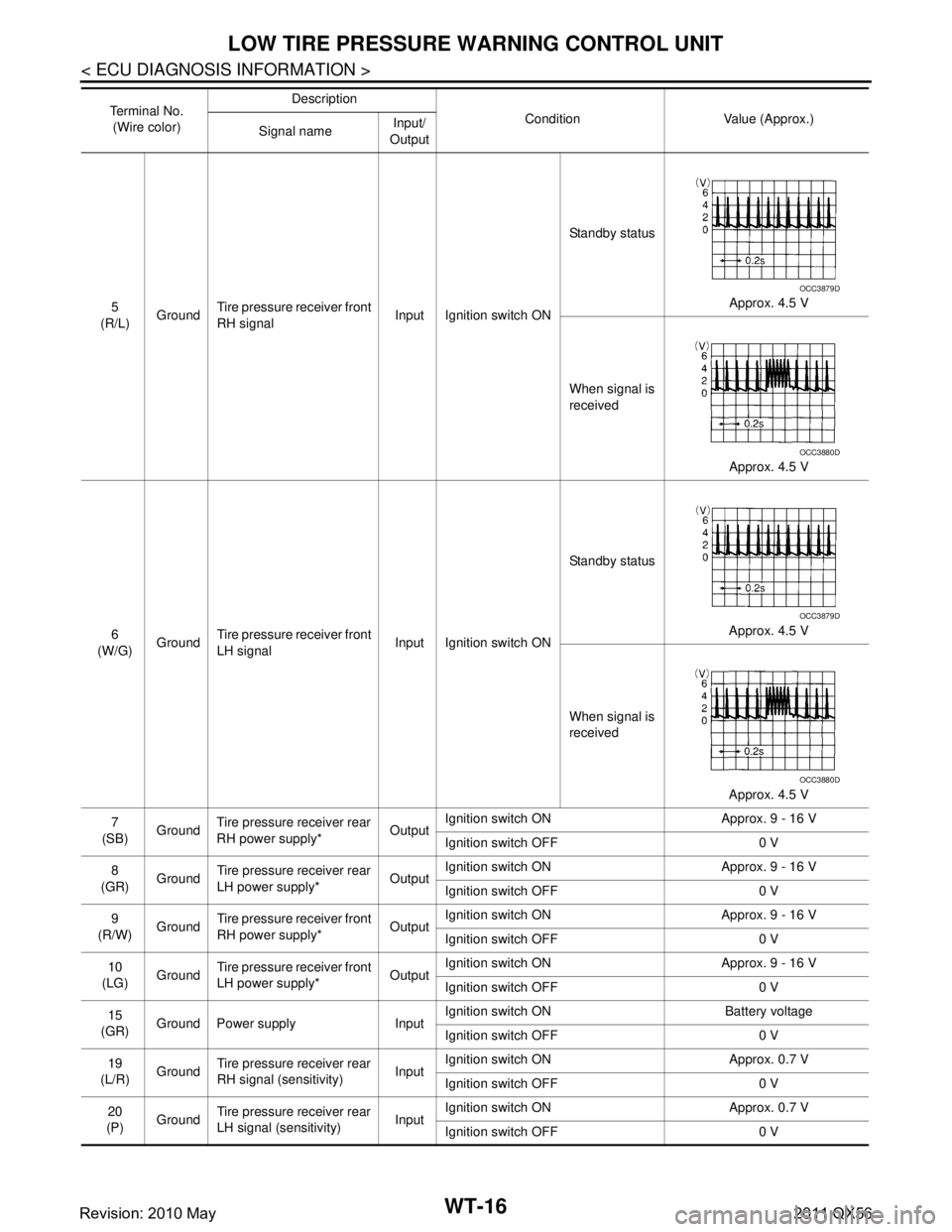
WT-16
< ECU DIAGNOSIS INFORMATION >
LOW TIRE PRESSURE WARNING CONTROL UNIT
5
(R/L) Ground
Tire pressure receiver front
RH signal Input Ignition switch ONStandby status
Approx. 4.5 V
When signal is
received Approx. 4.5 V
6
(W/G) Ground Tire pressure receiver front
LH signal
Input Ignition switch ONStandby status
Approx. 4.5 V
When signal is
received Approx. 4.5 V
7
(SB) Ground Tire pressure receiver rear
RH power supply*
OutputIgnition switch ON Approx. 9 - 16 V
Ignition switch OFF 0 V
8
(GR) Ground Tire pressure receiver rear
LH power supply*
OutputIgnition switch ON Approx. 9 - 16 V
Ignition switch OFF 0 V
9
(R/W) Ground Tire pressure receiver front
RH power supply*
OutputIgnition switch ON Approx. 9 - 16 V
Ignition switch OFF 0 V
10
(LG) Ground Tire pressure receiver front
LH power supply*
OutputIgnition switch ON Approx. 9 - 16 V
Ignition switch OFF 0 V
15
(GR) Ground Power supply Input Ignition switch ON Battery voltage
Ignition switch OFF 0 V
19
(L/R) Ground Tire pressure receiver rear
RH signal (sensitivity) InputIgnition switch ON Approx. 0.7 V
Ignition switch OFF 0 V
20
(P) Ground Tire pressure receiver rear
LH signal (sensitivity) InputIgnition switch ON Approx. 0.7 V
Ignition switch OFF 0 V
Te r m i n a l N o .
(Wire color) Description
Condition Value (Approx.)
Signal name Input/
Output
OCC3879D
OCC3880D
OCC3879D
OCC3880D
Revision: 2010 May2011 QX56
Page 5467 of 5598

LOW TIRE PRESSURE WARNING CONTROL UNIT
WT-17
< ECU DIAGNOSIS INFORMATION >
C
D F
G H
I
J
K L
M A
B
WT
N
O P
*: Power is supplied to the tire pressure receiver from the low tire pressure warning control unit.
DTC Inspection Priority ChartINFOID:0000000006225498
If some DTCs are displayed at the same time, per form inspections one by one based on the following priority-
chart.
21
(G/R) Ground
Tire pressure receiver front
RH signal (sensitivity) InputIgnition switch ON Approx. 0.7 V
Ignition switch OFF 0 V
22
(BR/Y) Ground
Tire pressure receiver front
LH signal (sensitivity) InputIgnition switch ON Approx. 0.7 V
Ignition switch OFF 0 V
23
(V/W) Ground Tire pressure receiver rear
RH ground
Input Always 0 V
24
(R/B) Ground
Tire pressure receiver rear
LH ground Input Always 0 V
25
(W/L) Ground Tire pressure receiver front
RH ground Input Always 0 V
26
(BR/W) GroundTire pressure receiver front
LH ground
Input Always 0 V
32
(B) Ground Ground — Always 0 V
Te r m i n a l N o .
(Wire color) Description
Condition Value (Approx.)
Signal name Input/
Output
Priority Detected items (DTC)
1 U1000 CAN COMM CIRCUIT
U1010 CONTROL UNIT (CAN)
2 C1704 LOW PRESSURE FL
C1705 LOW PRESSURE FR
C1706 LOW PRESSURE RR
C1707 LOW PRESSURE RL
3 C1755 PR RECEIV COND FL
C1756 PR RECEIV COND FR
C1757 PR RECEIV COND RR
C1758 PR RECEIV COND RL
4 C1708 [NO DATA] FL
C1709 [NO DATA] FR
C1710 [NO DATA] RR
C1711 [NO DATA] RL
5 C1716 [PRESSDATA ERR] FL
C1717 [PRESSDATA ERR] FR
C1718 [PRESSDATA ERR] RR
C1719 [PRESSDATA ERR] RL
7 C1728 RECEIVER ID NO REG
8 C1729 VHCL SPEED SIG ERR
9 C1750 [RECEIVER ERR] FL
C1751 [RECEIVER ERR] FR
C1752 [RECEIVER ERR] RR
C1753 [RECEIVER ERR] RL
10 C1754 CONT UNIT (EEPROM)
Revision: 2010 May2011 QX56
Page 5475 of 5598
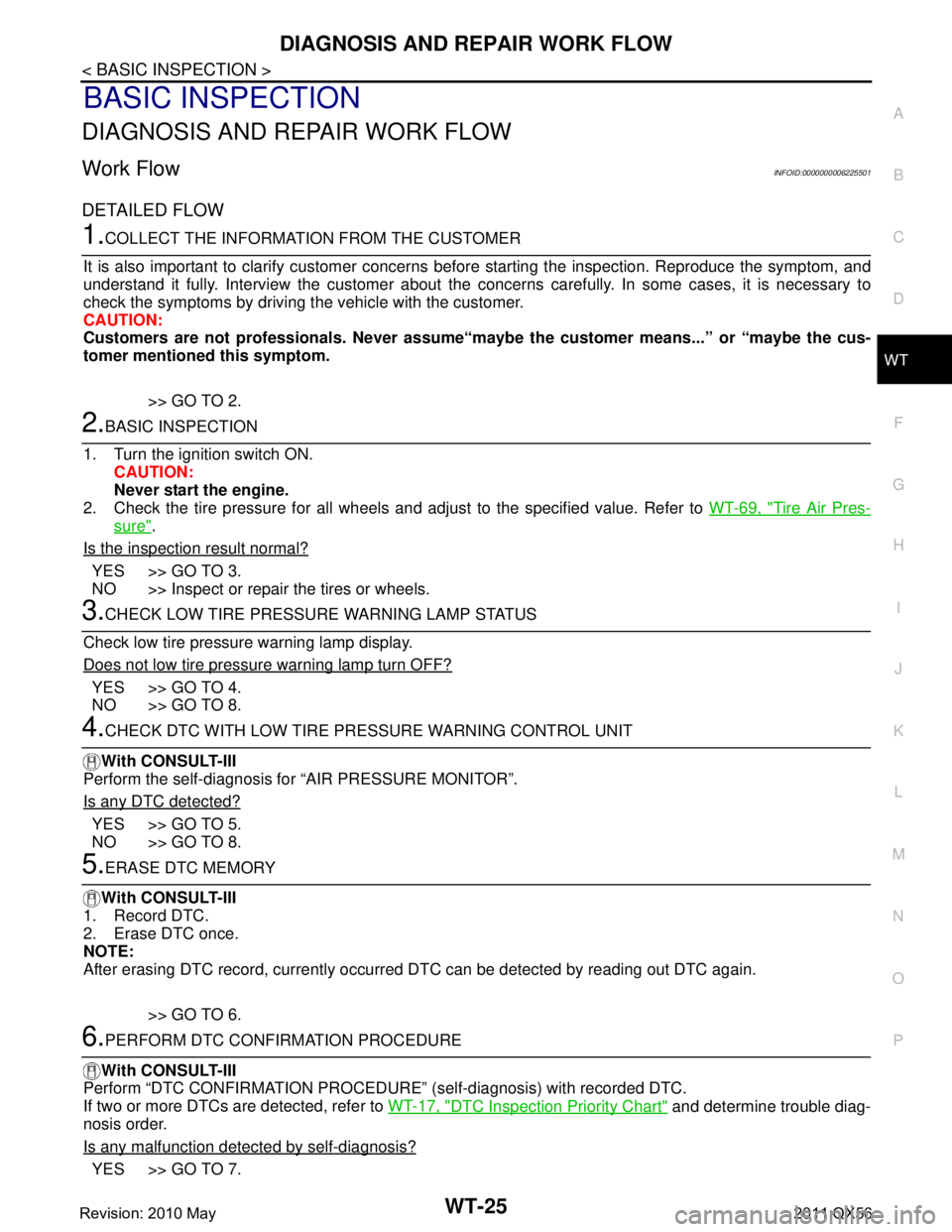
DIAGNOSIS AND REPAIR WORK FLOWWT-25
< BASIC INSPECTION >
C
DF
G H
I
J
K L
M A
B
WT
N
O P
BASIC INSPECTION
DIAGNOSIS AND REPAIR WORK FLOW
Work Flow INFOID:0000000006225501
DETAILED FLOW
1.COLLECT THE INFORMATION FROM THE CUSTOMER
It is also important to clarify customer concerns before starting the inspection. Reproduce the symptom, and
understand it fully. Interview the customer about the concer ns carefully. In some cases, it is necessary to
check the symptoms by driving the vehicle with the customer.
CAUTION:
Customers are not professionals. Never assume“mayb e the customer means...” or “maybe the cus-
tomer mentioned this symptom.
>> GO TO 2.
2.BASIC INSPECTION
1. Turn the ignition switch ON. CAUTION:
Never start the engine.
2. Check the tire pressure for all wheels and adjust to the specified value. Refer to WT-69, "
Tire Air Pres-
sure".
Is the inspection result normal?
YES >> GO TO 3.
NO >> Inspect or repair the tires or wheels.
3.CHECK LOW TIRE PRESSURE WARNING LAMP STATUS
Check low tire pressure warning lamp display.
Does not low tire pressure warning lamp turn OFF?
YES >> GO TO 4.
NO >> GO TO 8.
4.CHECK DTC WITH LOW TIRE PR ESSURE WARNING CONTROL UNIT
With CONSULT-III
Perform the self-diagnosis fo r “AIR PRESSURE MONITOR”.
Is any DTC detected?
YES >> GO TO 5.
NO >> GO TO 8.
5.ERASE DTC MEMORY
With CONSULT-III
1. Record DTC.
2. Erase DTC once.
NOTE:
After erasing DTC record, currently occurr ed DTC can be detected by reading out DTC again.
>> GO TO 6.
6.PERFORM DTC CONFIRMATION PROCEDURE
With CONSULT-III
Perform “DTC CONFIRMATION PROCEDURE” (self-diagnosis) with recorded DTC.
If two or more DTCs are detected, refer to WT-17, "
DTC Inspection Priority Chart" and determine trouble diag-
nosis order.
Is any malfunction detected by self-diagnosis?
YES >> GO TO 7.
Revision: 2010 May2011 QX56
Page 5478 of 5598

WT-28
< BASIC INSPECTION >
TRANSMITTER WAKE UP OPERATION
TRANSMITTER WAKE UP OPERATION
DescriptionINFOID:0000000006225504
When replacing transmitter, always transmitter wake-up is required.
Work ProcedureINFOID:0000000006225505
1.TRANSMITTER WAKE-UP PROCEDURE
1. Turn the ignition switch ON.
2. Press the transmitter activation tool (J-45295) (1) against the side of the tire at the location closest to the transmitter.
3. Wait until the indicator lamp turns OFF (approximately 5 sec- onds).
CAUTION:
Perform the wake-up procedure starting from the vehicle
front left wheel, then repeat the procedure in the order of
the front right wheel, rear right wheel, and rear left wheel.
4. Check that the low tire pressure warning lamp blinks in the pattern shown as per the following. The pattern
indicates that the transmitter wake- up procedure for the wheel is completed.
5. Check that the hazard warning lamp blink twice w hen the transmitter wake-up procedure for all wheels is
completed.
6. Check that the low tire pressure warning lamp turn s OFF, after the transmitter wake-up procedure is com-
pleted for all wheels and turns OFF.
Is the transmitter wake-up completed?
YES >> Perform the transmitter ID registration procedure. Refer to WT-29, "Work Procedure".
NO >> Perform trouble diagnosis for the transmitter. Refer to WT-33, "
Diagnosis Procedure".
NNEIC0020ZZ
JPEIC0089GB
Revision: 2010 May2011 QX56